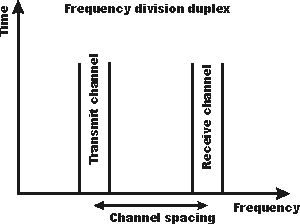Duplex transmission schemes for cellular telecommunications systems
an overview or tutorial explaining the forms of duplex transmission used
by cellular telecommunications systems including FDD and TDD
Basic radio communications systems use a single channel and
what is known as a press to talk system, where the user presses a button or
"pressel" on the microphone to talk, and then releases the pressel to listen on
the same frequency. This system is known as simplex as it uses a single channel.
For a phone system a full duplex system is required where it is possible to
speak in both directions at the same time. There are two main ways in which this
can be achieved. The first is to transmit in one direction on one frequency, and
simultaneously transmit in the other direction on another. To achieve this there
must be sufficient frequency separation and filtering to ensure that the
transmitter does not interfere with the receiver. A scheme that uses one
frequency for transmitting traffic in one direction and another frequency for
traffic in the other is known as Frequency Division Duplex (FDD).

FDD - frequency division duplex
The other system uses only a single frequency and can be
employed where digital or data systems are used. This requires the analogue
audio signal to be digitised. A single frequency is used for the radio frequency
signal and short packets of data are sent first in one direction, and then the
other. As these data bursts are relatively short the user does not notice the
short delay introduced by the fact that the digitised speech signal is not sent
immediately. This type of system is known as Time Division Duplex (TDD).

TDD - time division duplex
It is often necessary to distinguish between the link from
the mobile to the base station, and the link from the base station to the
mobile. The first, i.e. the link from the mobile to the base station is often
called the uplink or the reverse link as the signal is being transmitted up to
the base station. The second, i.e. the link from the base station to the mobile
is known as the downlink or the forward link.
|